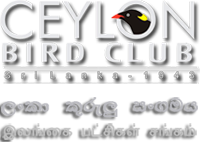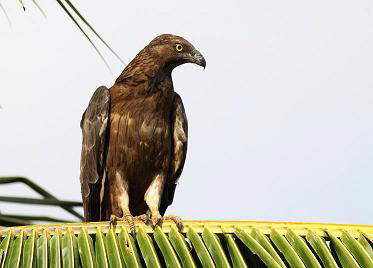


T W Hoffmann - CBCN March 2007 page 60 to 64
 Contrary to expectations (see CBCN 2007: 2), a pair of Crested Honey-Buzzards Pernis ptilorhynchus built a nest this year as well at Uva Ben Head Estate, Welimada.
Contrary to expectations (see CBCN 2007: 2), a pair of Crested Honey-Buzzards Pernis ptilorhynchus built a nest this year as well at Uva Ben Head Estate, Welimada.
On 12 February the birds started to deposit the usual material in the topmost upward fork of a Grevillea robusta tree. By the beginning of March they had put together an untidy heap of sticks, mostly dead or dry Grevillea branches broken off trees in the vicinity, as described in CBCN 2006: 56-58. Kitul Caryota urens fibre and Grevillea leaves were used to line the inside. Again, as in earlier cases, a strong Loranthus plant Scurulla parasitica was built into the structure, camouflaging the nest to some extent.
Vision was good because there was heavy Grevillea leaf-fall and a severe drought prevailed throughout. Day temperatures were 26-28º C, night 18-20º C. I was on the estate from 7 to 17 March. Daily for 4-5 hours I observed the birds and their behaviour.
Appearance and mating
One of the pair was undoubtedly the dark brown individual observed by me in December 2006 / January 2007 and described in CBCN January 2007 (see Naoroji 2006, text figure 27).
It soon became clear that this was indeed the male because during the next three days, 8-10 March, I observed mating on 10 occasions, five times during the morning of the 9th, between 7 a.m and noon. The act is very short and unspectacular. Whilst the female crouches on a stout horizontal branch, the male approaches her from front, opens and lowers his wings a little, mounts and lowers the wings covering the female, and then flies off to a nearby tree. The whole process takes about 30 seconds.
The dark brown male with clear grey head and brown eyes has faint bars on feathered thighs.
The female is a very handsome bird, slightly smaller than the male, with clearly differentiated plumage parts. Head, nape, throat and entire underside are yellowish fawn or yellowish buff, with dark streaks on upper breast and nape, thighs and lower belly, and spots on crown. There is a dark eye-stripe. No colour variation on throat and nor gorget, but a triangular streak on each side of the lower throat or upper breast could be interpreted as an indication of one. No bars on body but undertail feathers are faintly barred. On the ground she was nearly invisible due to her differentiated colouring.
Upperparts are dark brown in the roosting female, the feathers strongly edged especially on mantle and scapulars. In the flying bird the upperside looks almost sculpted in the contrast between dark and pale parts, and the rump is shiny yellow-buff. There is not a single picture (views from above are few) in Naoroji which would depict a similar bird.
Both the dark brown male and the pale female have the usual small crest low on the nape. The irides of the male are brown, of the female bright yellow.
It is possible, even probable, that the female is one of the two offspring of the only successful brood here so far, in March 2005.
Behaviour and nest building
On 10 March at noon the female laid an egg. A second may have followed or been delayed. From that time until the nest was given up about two weeks later brooding continued day and night.
During the days before egg laying both birds were on or near the nest from early morning until about noon and often for an hour or two in the evenings.
Both brought material for the nest intermittently but this labour had a perfunctory note about it; it seemed they were waiting for the egg /s. The male was far more active in collecting and bringing sticks to the nest where he and sometimes both birds together arranged them laboriously. Both shaped the central hollow in the stick platform by pushing the material towards the rim, using the breast. But the male was far more busy: the female was more of an onlooker who occasionally brought a stick. In contrast to the male she also broke off a few live branches with a few leaves. Later and shortly before egg laying she picked fresh Grevillea leaves which she arranged at the bottom of the nest hollow, and the male brought a fairly large cloth or garment, hanging like a flag from his feet in flight. I had not noticed the lining of the nest with leaves on earlier occasions, but this is widely reported as the norm in literature.
It seems clear that mainly the male built the nest. Up to the time of egg-laying he spent much more time in it arranging and shaping, and brought much more material than the female (who alone brought the lining).
The present male is also undoubtedly the bird I had observed in December / January breaking off nesting material even without a partner (CBCN 2007: 2)
The day before egg-laying mating took place five times during the morning, once on the nest. After the act the male would fly off, soon to return with a stick for the nest which both then arranged.
On the last days sticks were piled up along the edges reducing the view of the inside of the nest; there was a spurt of activity and the female plucked and brought Grevillea leaves.
Only once during the pre-laying period did the male offer food to the female. On the 8th at noon both flew to a low flat rock in the tea where the male left a sizeable piece of yellow honeycomb of which the female then ate a good part. On the 9th she ate a small green lizard slowly tearing off bit by bit. I did not see whether the male had brought it.
As the birds were absent during the afternoons I do not know whether food offering prior to laying took place more often or whether there was more frequent mating.
On the 10th the general pattern of behaviour changed. Whilst the male brought sticks which were used to raise the rim of the nest, the female mostly remained in it arranging and shaping. Again she collected some green leaves. As usual both birds were constantly within my view, never straying far from the nest. From 12 noon the female remained sitting in the nest, obviously having laid an egg, or two, over which she was now brooding. She remained all afternoon and throughout the night, occasionally shifting position.
Early in the morning of the 11th the male took over and the female was roosting on a tree nearby looking unkempt, bedraggled and sleepy (eyes mostly closed!). Later she returned to the nest and continued brooding. The male brought food three times, two lizards and what appeared to be a Palm Squirrel Funambulus palmarum or a tree rat.
From now on a regular pattern was followed. The female sat on the nest day and night, with the male relieving her for 1-2 hours every morning, rarely also at other times of the day. On the second day he brought a piece of honeycomb and on the third a green lizard. Thereafter feeding was not observed. It is probable that the female obtains food for herself during the periods when the male sits on the eggs.
When I left the estate on the 17th brooding had been going on for 8 days. It would continue in the same manner for 4 more days, making a total of 12 days. Both birds then ceased to brood. They remained at and around the nest for another week, and they abandoned it altogether on the 28th.
Harassment by crows
At the beginning of my period of observation Jungle Crows Corvus macrorhynchos were at times harassing either or both honey-buzzards so intensively and intimidatingly that I feared the latter might give up the site. The crows seem to do this for sheer mischief as in no way can these intelligent birds feel threatened by the harmless raptors.
Harassment was worst early morning when the honey-buzzards flew in. Usually one or the other or even both brought in their wake up to 8-10 Jungle Crows who would torment the roosting birds unceasingly and in relays for up to an hour or more. They would crowd up against the sitting buzzard and peck at its tail and wings. Often one or two crows were most persistent. The raptor would weakly flap its wings and open its beak, possibly hissing, at the crows. After some time of this it would fly off to another tree where the game would start afresh. When it got too annoying the buzzard would fly to a top end branch just strong enough to carry it - bending under the weight - but not an additional crow. After an hour or so, sometimes much less, the crows would lose interest and fly off, one by one.
During the first days of brooding harassment increased in intensity. Several crows would actually stand on the rim of the nest and peck at the sitting bird. Others, and at other times, would try to pull out sticks from the nest; at one time I feared they would bring it down as it was loosely constructed. The crows usually followed the male in the morning, when he flew in to relieve his mate. After a few days the crows seemed to lose interest in the nest and its occupant. From then until the nest was given up harassment was mild.
I had had great expectations of being able to record the second successful brood of honey-buzzards in this location. The question now is: what happened on or around the 20th, more than one month after nest build-ing started, and about 12 days after egg laying? Could it again have been a Black Eagle (see CBCN 2003: 50-52) or another raptor preying on the eggs? I doubt it, as I have not observed any recently. Could it have been a mammal, e.g. a Civet Cat? Unlikely. Were the eggs infertile - e.g., because the female was too young - and did the birds notice it? On the 27th, after the birds had abandoned the nest, a member of the estate staff climbed a neighbouring tree and looking into the nest did not see any evidence of eggs. As it could not have been due to the harassment by Jungle Crows, either, the abandonment must remain a puzzle.
So far the success rate of breeding Crested Honey-Buzzards at this location has been very low at 25% (2003-2007).
Generally in the literature the Crested Honey-Buzzard is now recognised as a breeding resident in Sri Lanka. Strangely, the distribution maps in some important works, e.g. Ferguson-Lees, Grimmet et al., show it as absent from Sri Lanka and South India. I continue to think that the form resident in Sri Lanka may be different.
References
Ferguson-Lees J & Christie D A (2001) Raptors of the World Christopher Helm.
Grimmett R, Inskipp C & Inskipp T (1998) Birds of the Indian Subcontinent. Christopher Helm / A & C Black.
Hoffmann T W (2003, 2006, 2007) Reports in: Ceylon Bird Club Notes February 2003, March 2006, January 2007.
Naoroji R (2006) Birds of Prey of the Indian Subcontinent Christopher Helm.